The internet has transformed our lives by connecting billions of people all over the world and changing the digital world.
This article showcases the latest internet trends with the help of interesting statistics. These statistics reveal the vast number of global internet users and the rapid growth of mobile connectivity, providing a glimpse into the dynamic nature of the internet.
Table of Contents
Our Top Internet Trend Statistics
- As of April 2024, there were 5.18 billion internet users worldwide, equivalent to 64.6% of the global population.
- Over the last ten years, global internet users experienced a significant surge of 13.9% growth in 2015, with an average annual growth rate of 7.4%.
- Every day, approximately 500,000 new internet users join the online community.
- From 2005 to 2021, the global number of internet users has witnessed a staggering 400% increase.
- Currently, global internet users are growing at an annual rate of 4%.
- As of 2022, 38% of the world’s population remains without internet access.
- Mobile device users account for nearly 55% of all website traffic, reflecting the significant role of mobile devices in online interactions.
Global and Regional Internet User Statistics
In this section, we will explore key statistics on global internet users, growth rates, and regional disparities, providing insights into the scale and impact of internet usage worldwide.
1. Number of Internet Users
The internet has experienced tremendous growth, with billions of individuals now connected to the digital realm.
- As of April 2024, there were 18 billion internet users worldwide, equivalent to 64.6% of the global population. Out of this, 4.8 billion individuals, representing 59.9% of the world’s population, were social media users (Source).
Global Internet and Social Media Usage (2013 -2024)
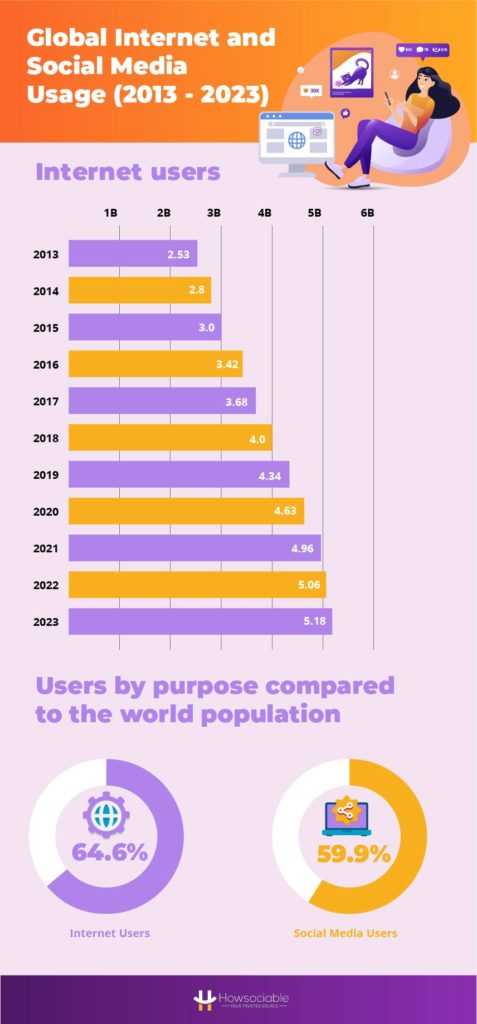
- Over the last ten years, global internet users experienced a significant surge of 9% growth in 2015, with an average annual growth rate of 7.4% (Source).
- Every day, approximately 500,000 new internet users join the online community.
- From 2005 to 2021, the global number of internet users has witnessed a staggering 400%
- Currently, global internet users are growing at an annual rate of 4%. (Source)
- Projections indicate that there will be approximately 5 billion internet users by 2030. (Source)
- As of 2022, 38% of the world’s population remains without internet access.
- In the year 2000, only 361 million people worldwide (6% of the global population at that time) used the internet.
2. Regional Disparities in Internet Access
While internet usage has seen significant growth, there are still notable disparities in access and connectivity across different regions:
- Approximately 37% of the world’s population, nearly 9 billion people, have no access to the internet. (Source)
Furthermore, the majority of this percentage resides in Africa, despite the Arabian Peninsula having high internet penetration rates.
Efforts are underway to address this disparity and extend internet connectivity to underserved regions, aiming to foster digital inclusion and bridge the gap.
3. Regional Internet Users
Examining the distribution of internet users across different regions reveals the diverse online presence around the world.
- East Asia leads the pack with approximately 2 billion internet users, making it the region with the highest number of online users (Source).
Global Internet Users by Region: Focus on East Asia and Southern Asia
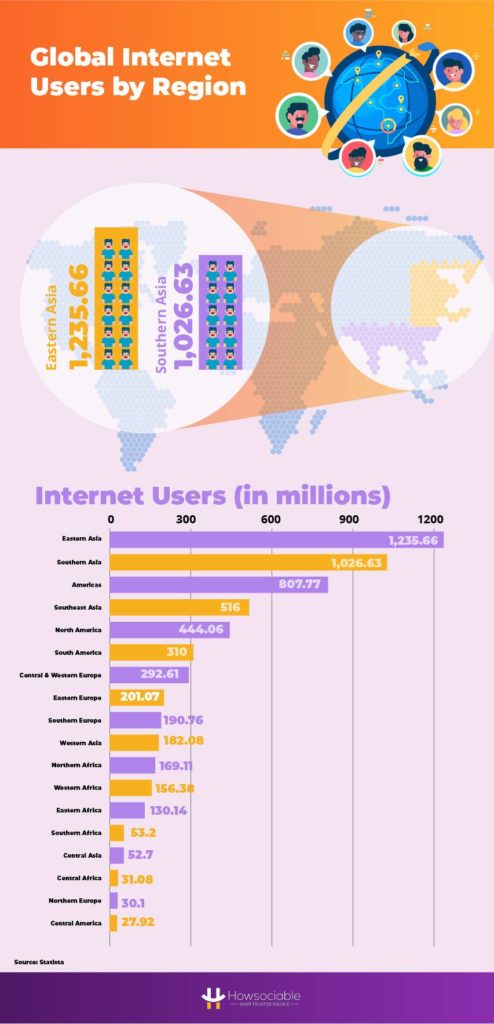
- Southern Asia follows closely behind, with over 1 billion Internet users, showcasing the significant online presence in this region (Source: Statista).
- China, in particular, stands out with a staggering 1 billion internet users, underscoring its influence in the digital world.
Internet of Things (IoT) Market Growth by Sector (2018 – 2028)
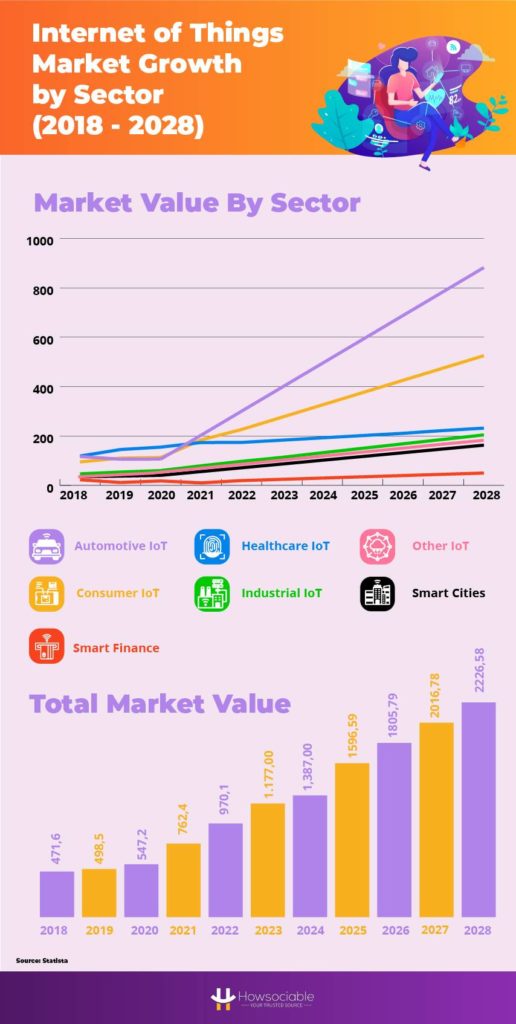
- The IoT Market size is expected to grow exponentially heading into 2028, at a massive CAGR during the forecast period (2018-2028).
Countries with the Largest Internet Usage in the World
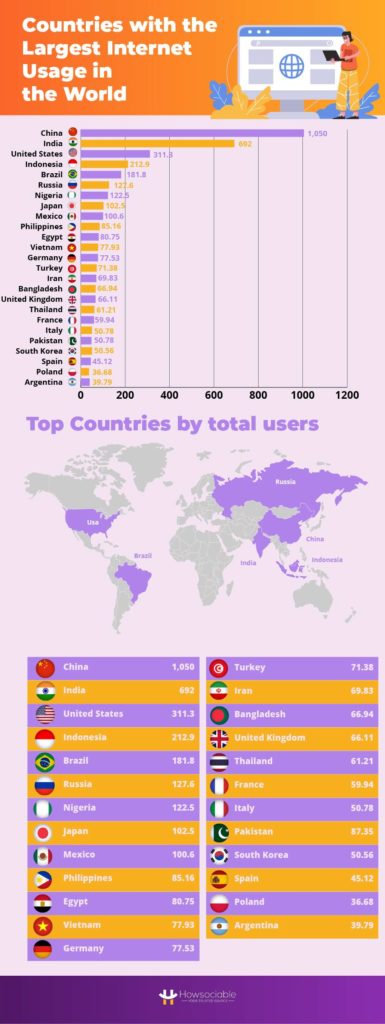
Certain regions play a crucial role in shaping the global internet landscape.
- The United States boasts a substantial online population, with 3 million internet users contributing to the country’s digital footprint. (Statista)
Regions such as East Asia and Southern Asia demonstrate significant online populations, while countries like China and the United States contribute significantly to internet usage.
Internet Usage Habit
From information-seeking to communication and entertainment, our internet usage habits shape our daily routines. Here are some fascinating statistics that reveal how people around the world engage with the internet.
Top Internet Usage Patterns (2024)
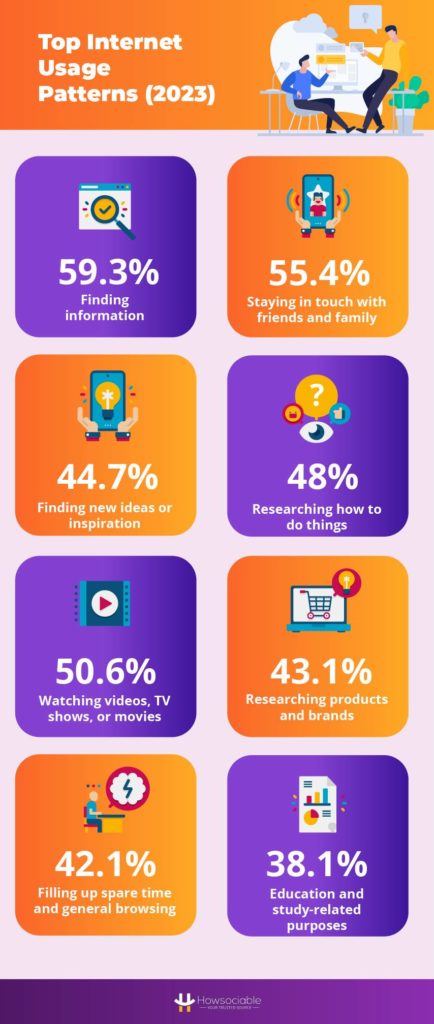
1. Browsing and Information Seeking
The internet serves as a vast repository of information, driving users to engage in browsing and searching activities:
- Approximately 59% of internet users primarily utilize the internet for browsing and searching for information, satisfying their curiosity and expanding their knowledge.
This activity allows individuals to delve into various topics, discover new ideas, and stay informed about the world around them.
7 Browsing Hacks No One Told You Before
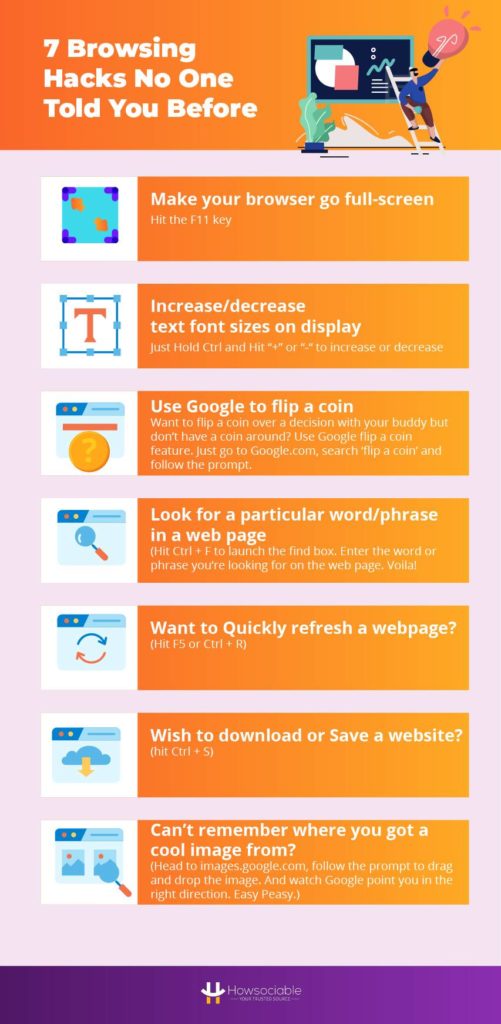
2. Staying Connected
The internet has revolutionized communication, enabling users to stay connected with friends and family regardless of physical distances:
- Over half of internet users (4%) leverage online platforms to maintain meaningful relationships and bridge geographical gaps.
Online communication tools, such as social media and messaging apps, play a pivotal role in connecting people and facilitating real-time interactions.
3. News and Information Access
The internet has become a primary source of news and information, revolutionizing the way we stay updated:
- Approximately 2% of internet users rely on online platforms to keep up with the latest news and events.
The internet’s real-time updates, diverse news sources, and personalized content recommendations enable users to access information tailored to their interests.
4. Online Entertainment
Digital platforms have transformed the entertainment landscape, providing users with a wide range of options for leisure and amusement:
- A significant portion of internet users (6%) indulge in watching videos, TV shows, and movies online.
Streaming services and video-sharing platforms offer convenient access to an extensive library of digital content, revolutionizing the way we consume entertainment.
5. Time Spent Online
The allure of the internet has led to an increase in the average time individuals spend online:
Average Daily Time Spent Online Worldwide (Q4 2022)
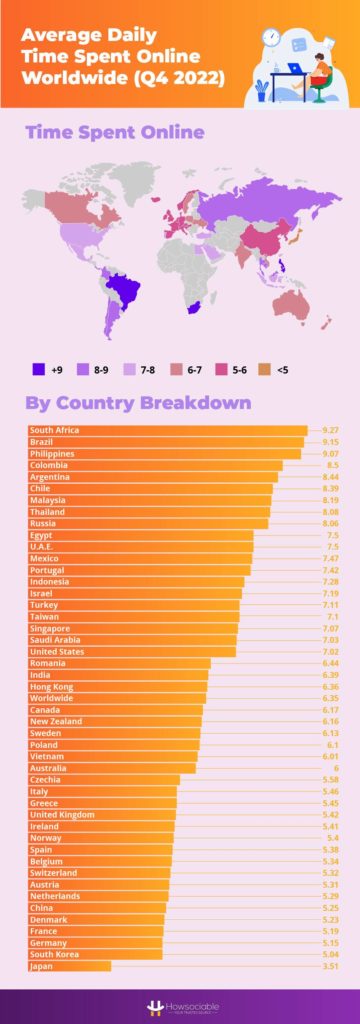
- As of 2022, the average internet user in South Africa spends a minimum of 9hrs 27 minutes online per day, immersing in various online activities. (Source)
- Over the past decade, internet usage has seen a substantial growth rate of 62%, indicating the growing importance of the internet in our daily routines. (Source)
6. Internet Usage in the United States
The United States stands as a significant player in the global internet landscape, with a high level of internet penetration and engagement:
- In the United States, 85% of the population uses the internet daily, showcasing the widespread adoption of online activities.
- Americans generate a massive amount of data every minute, with 3,138,420 GB of internet traffic flowing within the country. (Source)
Mobile Internet Usage and Connectivity
Mobile devices have transformed the landscape of internet usage, with their increasing dominance reshaping how we connect and access online content. In this section, we will explore the rise of mobile devices, the growth of mobile internet usage, the immense volume of internet traffic generated globally, and the widespread connectivity enabled by mobile devices.
1. The Rise of Mobile Devices
The proliferation of mobile devices has revolutionized internet usage, as smartphones and tablets have become the primary means of accessing online content. Consider the following statistics:
- As of June 2024, mobile device users account for nearly 55% of all website traffic, reflecting the significant role of mobile devices in online interactions (Source).
- In Q1 2015, mobile device internet traffic constituted less than one-third (31.16%) of total traffic. However, it has since experienced remarkable growth, increasing by approximately 75%. (Source)
This surge highlights the widespread adoption and reliance on mobile devices for internet access.
Q1 2017 marked a significant milestone as mobile traffic surpassed desktop traffic for the first time. This shift signifies the increasing preference for mobile devices as the primary tool for connecting to the internet.
Mobile devices have become the go-to option for accessing the internet, enabling connectivity and bridging the digital divide:
- Approximately 3% of internet users access the internet through a mobile phone, demonstrating the widespread prevalence and convenience of mobile connectivity (Source).
The Rise of Mobile Devices in Internet Access
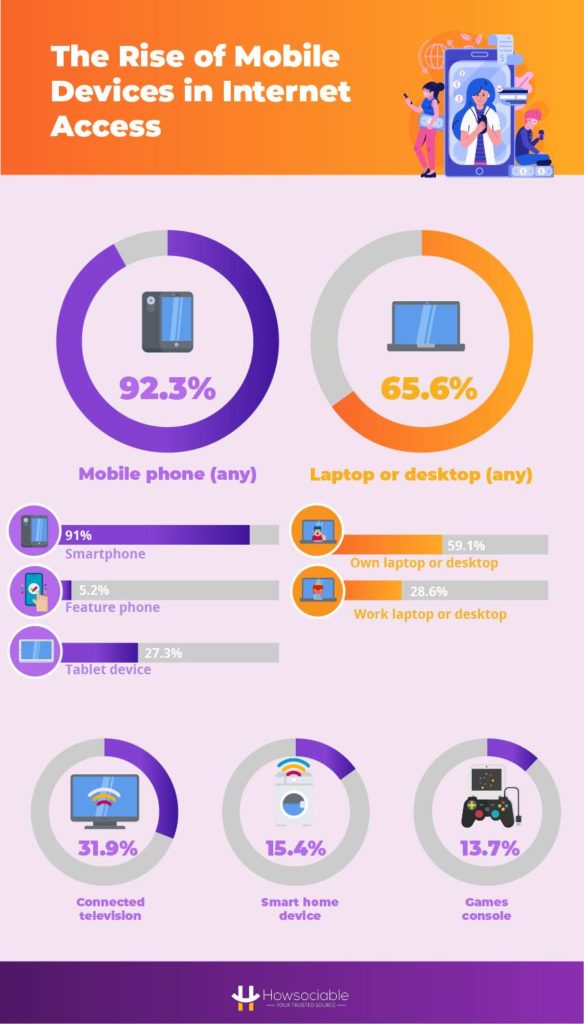
- Africa leads the way in mobile internet usage, with mobile devices accounting for 13% of total internet traffic in the region. (Source)
This emphasizes the vital role of mobile connectivity in providing access to information and opportunities, particularly in underserved areas.
2. The Advent of 5G Technology
The advent of 5G technology promises faster speeds, enhanced network capacity, and improved mobile internet experiences, further shaping the future of mobile connectivity.
- By 2025, it is projected that there will be over 1 billion 5G connections worldwide (Source).
Internet of Things (IoT) and Smart Devices
The Internet of Things (IoT) has become a driving force in shaping internet trends, revolutionizing the way we interact with technology and transforming various industries. The widespread adoption of IoT devices has paved the way for an interconnected ecosystem, enabling seamless connectivity, automation, and intelligent decision-making processes.
1. The Rapid Growth of IoT
The IoT landscape is experiencing rapid growth, with the number of connected devices increasing at an astonishing pace.
IoT-connected devices worldwide (2019 -2030)
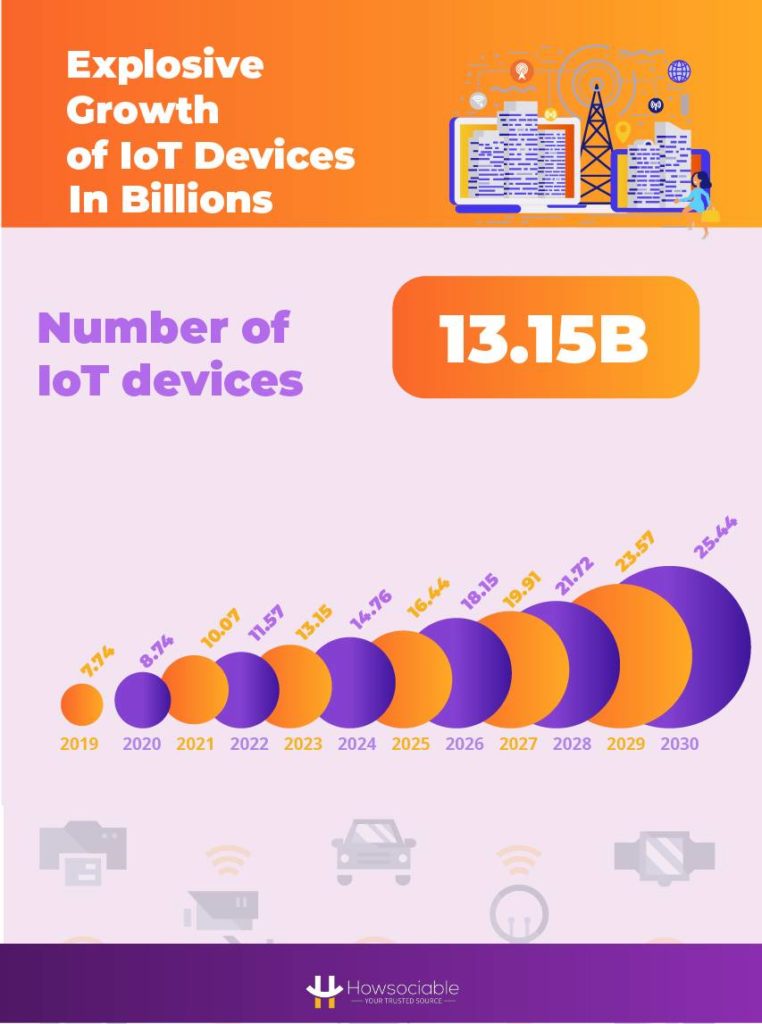
- Within the next seven years, the number of IoT devices is projected to exceed 25 billion, more than tripling from the current 15 billion (Source).
This growth is fueled by advancements in technologies such as 5G, which provide faster and more reliable connectivity.
2. The Shifting Landscape of IoT
There is a notable shift from traditional non-IoT devices to IoT devices, signaling the increasing prominence of IoT in our daily lives.
- By 2030, it is estimated that 75% of all devices will be IoT devices (Source).
This shift reflects the growing integration of IoT devices across industries and the rising demand for connected and intelligent solutions.
3. Increasing Number of IoT Platforms
The IoT ecosystem is supported by a growing number of platforms that enable device connectivity and data management.
- Over the years, the number of publicly known IoT platforms has more than doubled, from 260 in 2015 to 620 in 2019 (Source).
These platforms play a crucial role in facilitating interoperability among IoT devices and empowering developers to create innovative applications and services.
4. The Growing IoT Spending
Organizations are investing significantly in IoT solutions, recognizing the immense potential and value it brings.
Global IoT Spending on the Rise
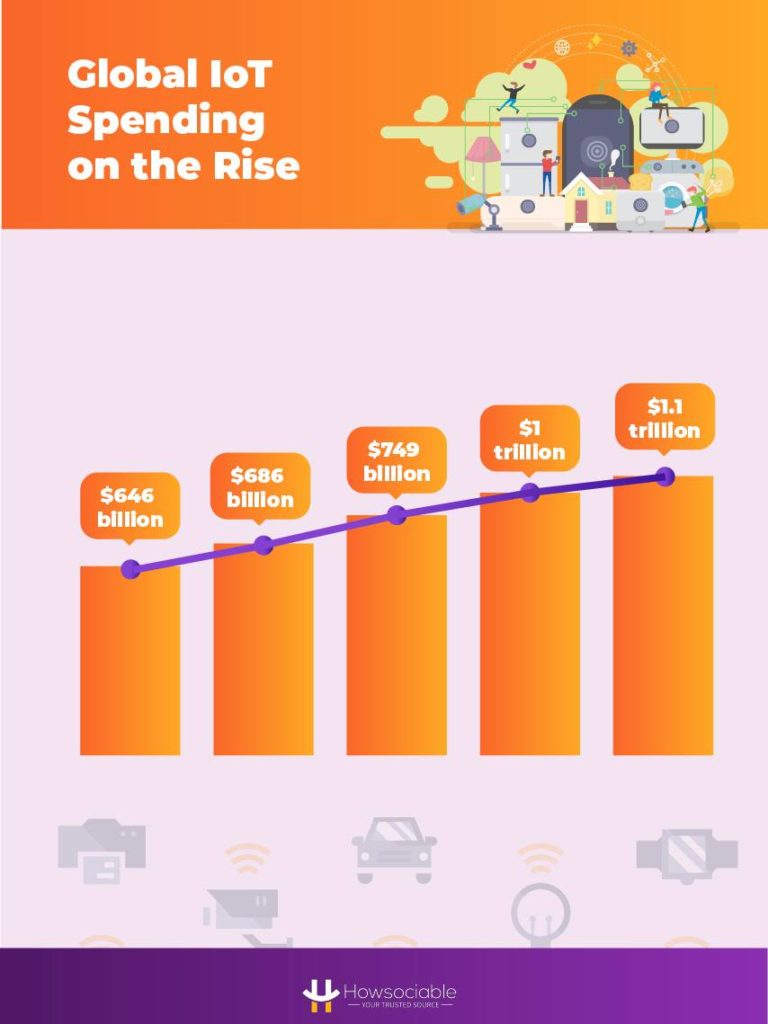
- Worldwide IoT spending is predicted to reach $1 trillion in the current year, reflecting the increased focus on harnessing the benefits of IoT technology (FinleyUSA).
This substantial investment highlights the economic opportunities presented by IoT and its potential to drive digital transformation across sectors.
5. Regional Distribution
The regional distribution of Internet of Things (IoT) connected devices provides insights into the areas leading in IoT adoption.
Regional Distribution of IoT Connected Devices

- Greater China takes the lead with an estimated 6 billion IoT connected devices by 2030. (Source)
- Europe showcases a strong presence in the IoT landscape, with a projected count of 6,557.4 million devices by 2030.
- North America follows closely, with an anticipated 6,243.1 million IoT connected devices by 2030.
- Other regions also show significant growth, including Japan (1,768.8 million devices), South East Asia (1,039.2 million devices), and Latin America (1,536.2 million devices).
These figures reflect the growing importance of IoT technology across various regions. Greater China’s dominance in IoT device adoption highlights its technological advancements and potential impact on industries and daily life.
6. The Revenue Potential of IoT
The revenue potential within the IoT market is vast and spans across various sectors.
- In 2024, the projected revenue for the IoT market is expected to reach $1,177.00 billion, with Automotive IoT being the largest market segment at $397.20 billion (Source).
This highlights the significant market opportunities and economic potential offered by IoT technologies.
7. IoT Security Concerns
As the IoT ecosystem expands, ensuring robust security measures is crucial to protect user privacy and maintain the integrity of connected devices.
- In 2021 alone, there were 5 billion cyber attacks targeted at IoT devices.
Addressing these security concerns has become a top priority, leading to the exploration of technologies like blockchain and end-to-end encryption to enhance IoT security.
8. IoT Adoption with Enterprises
Enterprises across industries are embracing IoT technology, recognizing its transformative potential.
- Approximately 93% of enterprises have adopted IoT technology in their operations.
This widespread adoption reflects the belief that IoT can drive efficiencies, enable data-driven decision-making, and unlock new business models.
9. IoT in Retail
The retail sector is experiencing the impact of IoT, with significant growth predicted in the coming years.
- By 2025, IoT in the retail market is expected to reach $35.5 billion, driven by the adoption of IoT-enabled solutions such as smart shelves, beacons, and inventory management systems (Source).
These technologies enable retailers to enhance customer experiences, optimize supply chain operations, and personalize marketing efforts.
The expansion of IoT platforms, coupled with the revenue potential and regional distribution, underscores the global significance of IoT technology. However, security concerns remain a critical challenge that must be addressed to ensure the trust and reliability of IoT systems.
Internet Traffic Generation and Mobile Internet Connectivity
The scale of internet traffic is truly staggering, reflecting the significant online activities taking place around the world.
- Every second of every day, a mind-boggling 59 billion gigabytes (GB) of internet traffic is generated.
This immense flow of data showcases the constant exchange of information, media, and services across the digital landscape.
Mobile devices have become integral to internet connectivity, offering accessibility and convenience to billions of users worldwide.
- There are approximately 32 billion active mobile internet users globally.
This vast number highlights the widespread adoption and reliance on mobile devices for accessing online content and services.
As technology continues to advance and connectivity becomes more pervasive, we can expect even greater volumes of internet traffic and a continued reliance on mobile devices for online interactions. The rise of mobile devices, the growth of mobile internet usage, and the widespread connectivity facilitated by mobile devices have significantly transformed the digital landscape.
Conclusion
The exponential growth of internet users, particularly in regions like East Asia and Southern Asia, highlights the increasing importance of digital connectivity. Mobile devices have become the primary means of accessing the internet, with mobile traffic surpassing desktop traffic. The rise of 5G technology and the rapid growth of IoT devices further demonstrate the ongoing evolution of the digital landscape. As we move forward, addressing issues of internet access, security, and privacy will be crucial in ensuring a more inclusive and trusted online environment.

Comments